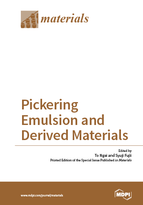Pickering Emulsion and Derived Materials
A special issue of Materials (ISSN 1996-1944).
Deadline for manuscript submissions: closed (30 June 2016) | Viewed by 74121
Special Issue Editors
Interests: colloidal particle; interfacial science; polymer and soft materials
Special Issues, Collections and Topics in MDPI journals
Interests: synthesis and characterization of polymer-based colloidal particles; particle at interface; particle-stabilized soft dispersed systems (emulsion, foam, liquid marble and dry liquid); design and synthesis of functional materials based on biomimetic technology; synthesis of element-block polymer materials
Special Issue Information
Dear Colleagues,
Particle-stabilized emulsions, today referred to as Pickering/Ramsden emulsions, are vital in many fields, including personal care products, foods, pharmaceuticals, and oil recovery. The exploitation of these Pickering emulsions for the manufacture of new functional materials has also recently become the subject of intense investigation. While much progress has been made over the past decade, Pickering emulsion still remains a rich topic since many aspects of their behavior have yet to be investigated. The present “Pickering Emulsion and Derived Materials” Special Issue aims to bring together research and review papers pertaining to the recent developments in the design, fabrication, and application of Pickering emulsions. The themes include, but are not limited to:
1. Interactions of colloidal particles confined at fluid interfaces
2. Pickering emulsion-based polymerization
3. Interfacial assembly and emulsion stabilization
4. Rheology of particle laden interfaces and Pickering emulsions
5. Functional materials templated from Pickering emulsions
We believe this Special Issue will serve as a platform for researchers to share their exciting works and, in the long run this will attract further attention and interest in the innovative development of this important and promising area.
It is our great pleasure to invite you to submit a manuscript for this Special Issue. Full papers, short communication, and review are welcome.
Dr. To Ngai
Dr. Syuji Fujii
Guest Editors
Manuscript Submission Information
Manuscripts should be submitted online at www.mdpi.com by registering and logging in to this website. Once you are registered, click here to go to the submission form. Manuscripts can be submitted until the deadline. All submissions that pass pre-check are peer-reviewed. Accepted papers will be published continuously in the journal (as soon as accepted) and will be listed together on the special issue website. Research articles, review articles as well as short communications are invited. For planned papers, a title and short abstract (about 100 words) can be sent to the Editorial Office for announcement on this website.
Submitted manuscripts should not have been published previously, nor be under consideration for publication elsewhere (except conference proceedings papers). All manuscripts are thoroughly refereed through a single-blind peer-review process. A guide for authors and other relevant information for submission of manuscripts is available on the Instructions for Authors page. Materials is an international peer-reviewed open access semimonthly journal published by MDPI.
Please visit the Instructions for Authors page before submitting a manuscript. The Article Processing Charge (APC) for publication in this open access journal is 2600 CHF (Swiss Francs). Submitted papers should be well formatted and use good English. Authors may use MDPI's English editing service prior to publication or during author revisions.
Keywords
- Particle-stabilized emulsions
- Particle interaction at the interface
- Pickering emulsion-based polymerization
- Emulsion stabilization
- Interfacial assembly
- Rheology of interfacial particles and Pickering emulsions
- Functional materials








